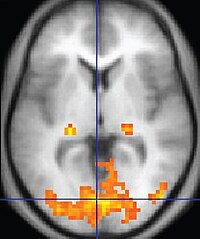
Photo from wikipedia
BACKGROUND Cerebrovascular reactivity (CVR), an important measure of cerebrovascular health in adults, has not been examined in healthy adolescents. Beyond the direct importance of understanding CVR in healthy youth, studies… Click to show full abstract
BACKGROUND Cerebrovascular reactivity (CVR), an important measure of cerebrovascular health in adults, has not been examined in healthy adolescents. Beyond the direct importance of understanding CVR in healthy youth, studies on this topic can yield insights regarding brain disease. We set out to evaluate 3 different CVR modelling approaches. NEW METHOD Thirty-nine healthy adolescents (ages 13-19 years, 20 females) completed six blocks of 15-second breath-holds separated by 30-second blocks of free-breathing. CVR was measured using blood-oxygenation-level dependent functional magnetic resonance imaging at 3-Tesla; voxel-wise analyses were complemented by regional analyses in five major subdivisions of the brain. Hemodynamic response functions were modelled using: (1) an individualized delay term (double-gamma variate convolved with a boxcar function), (2) with a standard 9-second delay term, and (3) a sine-cosine regressor. RESULTS Individual-delay yielded superior model fit or larger cluster volumes. Regional analysis found differences in CVR and time-to-peak CVR. Males had higher brain-wide CVR in comparison to females (p = 0.025, η2part = 0.345). BMI and blood pressure were not significantly associated with CVR (all p > 0.4). COMPARISON WITH EXISTING METHODS This was the first study to compare these methods in youth. Regional differences were similar to adult studies. CONCLUSIONS These findings lend support to future breath-hold CVR studies in youth, and highlight the merit of applying individualized-delay estimates. Regional variability and sex-related differences in CVR suggest that these variables should be considered in future studies, particularly those that examine disease states with predilection for specific brain regions or those diseases characterized by sex differences.
Journal Title: Journal of Neuroscience Methods
Year Published: 2018
Link to full text (if available)
Share on Social Media: Sign Up to like & get
recommendations!